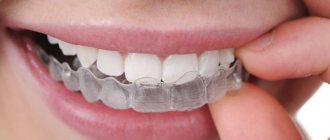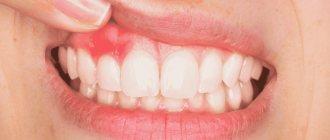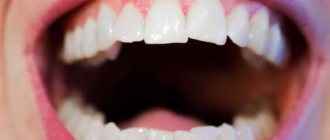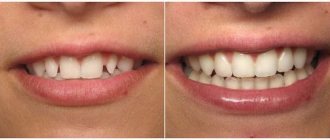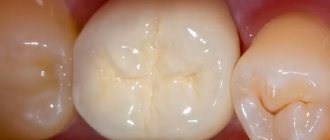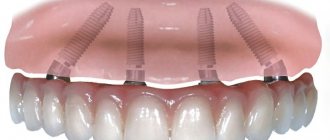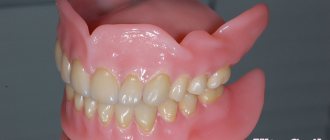Many patients of orthopedic dentists after prosthetics talk about how difficult it was for them to get used to dentures. High-quality permanent artificial teeth and crowns are compact in size and do not cause any discomfort. But with removable ones, problems arise: from unpleasant sensations in the palate and irritating pressure on the gums to constant nausea and even a gag reflex. Each patient experiences the adaptation process in his own way, so it can last only a couple of days, one or two weeks, or several months.
Why does discomfort occur?
A person with missing teeth gets used to living without them. His dental system begins to distribute the chewing load differently, and the muscles, cheeks, nerves, tongue and jaw bones involved in the process gradually get used to the restructuring that has occurred.
If missing teeth can be restored with permanent dentures, the parameters of which are almost identical to natural teeth, the load when chewing food turns out to be natural. And the absence of foreign elements - fixing hooks and staples - guarantees the absence of irritation of the mucous membranes of the cheeks and tongue.
In removable structures, the chewing load is distributed differently. For example, popular clasp dentures distribute it to the palate and the remaining adjacent teeth. It is clear that the sensations when chewing food will be unusual at first and will almost certainly cause irritation.
Why are crowns needed?
This prosthesis is necessary for people when their teeth have significant damage.
As a rule, teeth are destroyed due to advanced caries, when a course of dental canal treatment has been completed, or due to injury. All these cases can lead to the tooth being severely damaged and close to destruction. It is unreasonable to install a filling in such a situation, so it is necessary to resort to the help of prostheses. This problem most acutely concerns pulpless teeth. The fact is that in the absence of pulp, the tooth is deprived of nutrition. Because of this, its walls become more fragile over time and will sooner or later crack. It often happens that a crack runs throughout the entire tooth. This means that a tooth that was not problematic yesterday, but which could last for a long time, is completely removed by a doctor today.
What inconveniences can you encounter after prosthetics?
Dentists installing dentures in Moscow warn in advance about possible discomfort that may manifest itself:
- noticeably irritating sensation of a foreign body in the oral cavity;
- pain caused by the pressure of the structure on the supporting teeth and especially the gums;
- rubbing of mucous membranes, redness and swelling, formation of bedsores on the gums;
- a feeling of poor closure of the jaws and teeth;
- increased salivation caused by the perception of the prosthesis as food that needs to be easier to move from the mouth to the throat;
- the appearance of gagging as a reaction to the presence of a foreign body in the mouth;
- impaired diction, which can be caused by even the best removable dentures (the tongue needs time to get used to changing position when pronouncing sounds);
- partial loss of taste of products caused by the closure of certain areas of the oral mucosa by the prosthesis.
Adaptation to new crowns and dentures.
What do you need to know?
Modern dentistry has made great strides, with its help you can make your smile truly radiant.
However, many types of treatment require patience and endurance from the patient. Adaptation to a denture takes a lot of time. Therefore, it is necessary to listen to specialists who give valuable recommendations on how to get used to dentures in a short period of time. When the prosthetics are completed, we recommend not to eat hard food for a couple of days - it’s not quite familiar yet and you can accidentally bite your lip, cheek or tongue. While eating, chew slowly, control the movement of food in different directions, as well as the position of the lips and tongue while eating (to avoid injury to the mucous membrane). Eliminate hard and viscous foods (nuts, crackers, crackers, hard sausages, persimmons, chewing gum, etc.). Remember, the facial and chewing muscles are not yet ready to function in a new position after prosthetics. Xerostomia (dry mouth) or increased salivation may occur.
There is a feeling of limited space for the tongue.
After restoration of the height (increase) of the bite, a restructuring of muscle reflexes occurs.
Irritability, sleep disturbance, and minor discomfort in the muscles and temporomandibular joints are also possible. The first few days the diction may even be changed. This happens when prosthetics involve several front teeth. Which decisively influence, and indeed create, diction and phonetics. To speed up adaptation, more training is recommended: talking more, chatting on the phone, perhaps using myogymnastics, i.e. talk in front of the mirror. The more training, the faster pronunciation is restored.
Often these phenomena disappear after 2 months of using orthopedic structures.
We must also remember that there are teeth under the crowns, and while crowns can withstand barbaric treatment of them, teeth cannot always. Therefore: do not limit food intake and treat the crowns as if they were your own teeth. Eat as usual, do not conduct experiments (open bottles, chew bones, metal or wires), brush as you would your teeth.
Clean and care for crowns in the same way as other teeth. No additional care required. After eating, you can rinse your mouth with plain water to wash away all the remaining food from under the artificial teeth. If it gets stuck between the crown and an adjacent tooth, then clean it with floss (dental floss), a brush or an irrigator.
Food should not get under the crowns themselves. But for artificial teeth - maybe. Let me explain.
Artificial teeth can be made very tightly to the gum. Modern impression materials and technologies make it possible to do this easily. But in this case, food will certainly get between the artificial tooth and the gum. The gums are very pliable. While chewing food, small pieces can move it away and squeeze between it and the artificial tooth. There is no way to get them out of there. This will cause gum inflammation over time. Everyone knows that any inflammation is accompanied by edema, that is, an increase in volume. The gums will “hug” the remaining food. It will be impossible to get to him at all. Inflammation will increase, and the gums will swell even more. It's a vicious circle. This can only be stopped by removing the remaining food. But it’s unlikely to be possible to do this on your own.
To prevent this, a distance is created between the artificial tooth and the gum. Officially, this gap is called the flushing space. This was not invented by us - this is done all over the world. That is, when making crowns with artificial teeth, rinsing spaces are required. They make it possible to wash away all food residues by simply rinsing with water.
It is important to know that... a) Brush your teeth and dentures regularly, at least twice a day. Brush the contact and side surfaces of the bridge with a toothbrush in the same way as natural teeth. b) To clean the spaces between teeth, dental floss (floss), toothpicks, special interdental brushes, brushes and an irrigator can be used. Clean the inner surface of the denture, as well as the interdental spaces of the bridge, especially carefully. c) The surface of the dental crown and adjacent gums is best cleaned with a brush, using regular toothpaste (but not abrasive, which can damage the surface of the denture). At the same time, try to actively carry out sweeping movements at an angle of 45°, directed from the gums to the cutting edge or chewing surface of the prosthesis. d) After cleaning the denture, it is recommended to rinse the oral cavity thoroughly with water or mouthwash.
We wish you patience and health!
Do not forget that the success of treatment now largely depends on you.
Performed by orthopedic dentist S.V. Mogilnikov.
Do you really have to put up with this?
Making dentures is quite a complex job, in some ways even comparable to art. Working in tandem, the orthopedic surgeon and the dental technician put a lot of effort into making an accurate and as comfortable prosthesis as possible. But in most cases, after putting it on and wearing it, it turns out that it needs some adjustment to the patient’s gums.
To regain lost comfort, you need to walk with the installed structure for 3–4 weeks. During this time, you can get used to the initially interfering prosthesis and get rid of the unpleasant sensations. If you simply remove it when discomfort appears, then you will have to describe all the inconveniences experienced in words, and the doctor will not be able to understand what exactly caused them. Do you want the correction to be effective? Be sure to come to your appointment wearing a prosthesis that causes discomfort.
Correction of dentures is carried out within 15–20 minutes. As a rule, it is possible to restore the patient’s comfort in one or two visits to the dental clinic.
What to do if a temporary crown comes off?
The first thing to do in such a situation is to call your doctor.
You will discuss with him the urgent measures that need to be taken, and will also schedule an appointment to re-attach the crown. Most likely, he will suggest putting the crown back in for a while. This is necessary to protect the tooth from damage, displacement, and other things. The inserted crown may not sit completely, causing a feeling of discomfort. In this case, you do not need to insert it, just wait until you see a doctor, and before that, try not to eat hard, cold or hot foods. If it fits well, but not securely, then you can fill it from the inside with Vaseline or toothpaste.
Inflammation of the salivary gland
The salivary glands are responsible for the process of producing saliva, which is necessary for the primary digestion of food and protecting the oral cavity from pathogenic microorganisms. At the initial stage, the inflammation passes without symptoms. The patient seeks medical help in more advanced cases. Lack of therapy threatens with impaired salivation, salivary stone disease and blockage of the salivary ducts. Manifests:
- swelling of the chin, lower jaw and nearby tissues;
- increased temperature;
- pain when swallowing, chewing food, opening the mouth;
- daily deterioration of health.
Why is this happening?
If inflammation of the salivary gland (sialadenitis) occurs after installation of the implant, the cause may be damage to the duct during drilling of the site for the titanium rod. Other reasons:
- inflammatory process in the tonsils;
- poor hygiene;
- infectious diseases, such as tonsillitis;
- stagnation of secretions in the ducts;
- starvation;
- dehydration;
- inflammation of the lymph nodes;
- carious teeth.
Troubleshooting
It is important to correctly identify the cause of the problem, which only a doctor can do. If the disease occurs due to exposure to bacteria, antibiotics related to cephalosporins or penicillins are prescribed into the gland duct. If the cause is a virus, irrigation with Interferon is necessary. In case of an abscess, the purulent focus is opened, cleaned and drained. After dissection, the following are prescribed:
- UHF;
- electrophoresis;
- galvanization;
- rinsing.
If these measures do not bring results, a course of intramuscular antibiotics and sulfonamides is prescribed. It is also necessary to take medications that enhance saliva production (Pilocarpine, potassium iodide) and quit smoking.
The chronic form of the disease is practically untreatable, which is why therapeutic procedures are carried out during the period of exacerbation.
Do I need to see a dentist?
If an inflammatory process occurs, then professional therapeutic treatment is necessary. To do this, the crown is removed without the possibility of reusing it. After sanitation, it is necessary to monitor the dynamics for some time, and it will be possible to resume orthopedic treatment only when the absence of inflammation is confirmed.
If you feel that the crowns are interfering with your bite, you do not need to fix the problem yourself. Seek help from a specialist as soon as possible. Without the intervention of a specialist, restoration of the bite is impossible. If the teeth meet in a certain place, and not evenly, then many problems can arise. Among them: increased tooth wear, gaps in teeth and other complications.
Important!
If for some reason your doctor does not want to redo his work, then you need to contact another specialist, but you should not delay the solution to this problem.
White, yellow, brown or black plaque appears
Normally, the tongue should have a pale pink color, perhaps a light white coating that can be easily removed with a toothbrush. Sometimes after implantation the patient develops a coating on the tongue. However, this is not always the reason.
What does it come from?
- Bad habits . Smoking and drinking alcohol negatively affect the condition of the teeth and mucous tissues of the oral cavity, giving them a brown tint.
- Food . Products containing caffeine (black tea, chocolate, coffee) can turn the tongue brown.
- Medications . Due to taking medications containing dyes, the tongue becomes covered with a brown coating. The side effect disappears after completing the course of treatment.
- Fungal infections . Diseases caused by yeast fungi (mycosis, stomatitis) provoke the formation of plaque, which at first has a white tint, then becomes yellow or brown. With stomatitis, the oral cavity is lined with small pimples, which gradually merge into one blister that develops into a wound.
- Pathologies of the gastrointestinal tract . Dysbacteriosis, ulcers, gastritis, reflux can cause plaque formation. The shade can be either light or dark, depending on the severity of the disease.
- Liver diseases . Serious liver diseases (hepatitis, cholecystitis) can turn the tongue yellowish, and even cause it to turn black.
- Insufficient amount of vitamin B in the body . Element deficiency is a consequence of poor nutrition, including large amounts of carbohydrates, sweets, and alcohol.
Treatment
Therapeutic measures to remove plaque depend on the cause. It is necessary to consult a dentist, gastroenterologist, therapist, hematologist and infectious disease specialist. Once the causes are identified, the following may be prescribed:
- antifungal agents;
- rejection of bad habits;
- exclusion of products that have a coloring effect;
- introducing foods containing increased amounts of vitamin B into the diet;
- treatment of gastrointestinal tract pathologies;
- professional cleaning of the oral cavity by a dentist.
If your tongue is knotted and your mouth feels dry
Dry and sticky mouth is a sign of insufficient saliva production. It becomes a consequence of stress, and regular discomfort indicates illness.
Possible reasons
- Side effects of medications. More than 400 species negatively affect the oral mucosa. These are antihistamines, painkillers, decongestants.
- HIV, AIDS, diabetes mellitus, Parkinson's disease, vitamin deficiency, Hodgkin's disease.
- Impact of radiation and chemotherapy.
- Menopause. Hormonal levels affect the functioning of the salivary glands.
- Smoking, drug addiction.
- Consuming a lot of salt.
- Allergic reaction, liver and kidney diseases, seborrhea.
Does it hurt to put a crown on a tooth?
The presence of a pain symptom during installation of a crown on a tooth depends on the tooth:
- on the pulpless one the pain is not felt. However, if you ask for additional anesthesia, they will give it;
- on “living” teeth, with the root preserved, there is an unpleasant sensation, pain is felt during grinding. Anesthesia solves the problem, but it is advisable to do a test to avoid an allergic reaction.
When installing dental crowns, when a temporary prosthesis is installed, the edge of the gum may be damaged and discomfort may be felt, but this is a normal process - no medications are required. If there is increased nervous excitability, the pain threshold is low - you can take sedatives and painkillers (be sure to discuss this issue with your dentist!).
How to care for a crown
Both the dentist and the patient are interested in the crown serving its intended purpose for a long time. To increase the period of good functioning of the prosthesis, a person will need additional care products, because a standard toothbrush is not able to clean the removable element:
- The beam brush is designed to clean the internal surfaces of the prosthesis;
- The interproximal brush on the head contains a special brush that easily reaches hard-to-reach places on the lateral surfaces of the prosthesis, cleans the areas between the crown and adjacent teeth;
- Floss is required for regular cleaning of interdental crevices;
- If the household has an irrigator, it will be a constantly in demand device, because only it can clean the areas in the cervical fastenings of crowns.
How much does it cost to install a crown on a tooth?
The final cost of prosthetics depends on the crown material, treatment plan, associated costs (radiovisiograph image, impression, anesthesia, etc.).
| Type of crown | Price for 1 tooth, rub. |
| Metal | From 4500 |
| Metal ceramics | From 9000 |
| Zirconium dioxide | From 17500 |
| Plastic | From 2000 |
| Metal-plastic | From2500 |
| Sitall | From 14000 |
| Ceramics | From 13000 |

